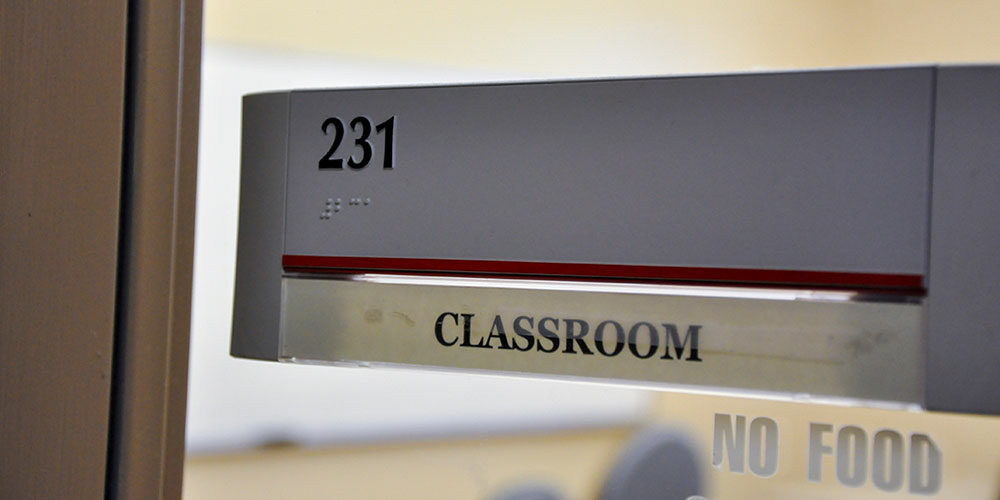Lawmakers Push to Amend Mass. Building Codes to Allow Barricade Locks
Bay State school districts can apply for variances from local inspectors to install the devices, most of which violate ADA and NFPA codes.

Photo: BONNIE C. MARQUETTE - stock.adobe.com
BOSTON — Massachusetts legislators have proposed changing the state’s building and fire codes to allow for the installation of certain types of barricade locks on classroom doors.
The devices, which are metal tabs that slip into a slot and prevent doors from being pushed or pulled open, are installed near access points and are intended to save lives by preventing active shooters from entering classrooms or other areas where students, faculty, clinicians, or others might be taking shelter.
“We have seen shootings where students and teachers have been tragically injured or killed,” said Sen. Michael Moore (D-Millbury), one of two legislators who filed bills to amend the existing state codes. “These barricade door locks provide the technology to be used, on a temporary basis, to create a safe harbor in school classrooms.
“The Department of Homeland Security has determined that properly locked doors can have a significant impact on the outcomes of an active shooter event, particularly when combined with adequate lockdown procedures,” he says.
Under current law, Massachusetts school districts can apply for a variance from local building and fire inspectors to install the devices, Newsbreak reports. However, the devices come with risk because they could prevent individuals with disabilities and, under some circumstances, even persons who don’t have any disabilities from evacuating a building during an emergency, such as a fire.
Most devices on the market violate the Americans with Disabilities Act (ADA) as well as National Fire Protection Association (NFPA) codes.
About 20 districts have installed the devices but some have been denied variances, says Moore.
“In the horrific event that a shooter targets a Massachusetts public school, we must make sure teachers and students have tools available to protect themselves and minimize the risk of injury,” he wrote in a release.
“Numerous studies have shown that barricading classroom doors during a school shooting is one of the most effective ways of protecting those inside, but barricading takes time, organization, and able-bodied individuals who can move heavy furniture,” the release says.
One of the proposed bills, which was presented to the Joint Committee on Public Safety and Homeland Security on Dec. 11, would direct the Executive Office of Public Safety, the Executive Officer of Education, and the School Building Authority to write new regulations that would dictate what situations the locks can be used in.
The regulations would also need to go through a local approval process in cities and towns, including consultations with fire and police departments, according to WWLP. Additionally, it calls for educators in districts that opt into using these locks to get trained by first responders and for annual inspections of the devices.
“This is not a mandate,” said Rep. Jeffrey Turco of Winthrop, the bill’s co-sponsor in the House. “It’s simply a requirement that EOPSS put in place regulations that allow this, and then obviously, ultimately, school districts can then make a determination for themselves whether or not this added safety protection is something that they are interested in.”
Fire Marshal: Barricade Locks Don’t Comply With Building Code
Under the State Building code, all egress doors must be “readily openable from the egress side with a single operation and without the use of a key, special knowledge or effort,” State Fire Marshal Jon Davine wrote in a document the state Department of Fire Services prepared in conjunction with the Department of Elementary and Secondary Education.
According to Newsbreak, additional requirements for school door locks include:
- No tight grasping, pinching, or wrist-twisting to operate a lock
- Locking hardware must be installed between 34 and 48 inches above a finished floor
- Manually operated bolt locks or surface locks are not permitted
- Unlatching of a door or door leaf must be completed in one action
- Electromagnetic locks are approved for use
- If a latching door serves 50 or more people, panic or fire exit hardware is required along the means of egress
Davine noted in the document that the “majority of retrofit classroom door security and barricade devices do not comply with the requirements of the building code,” but that door-locking devices are available that do comply and can “provide a level of safety while still maintaining egress from within a classroom.”
One of those devices, TeacherLock, was created by Salvatore and Amy Emma, the latter of whom is the former principal at a Massachusetts school.
“It was a long process,” he said. “We worked with the state and the state fire marshal. They helped guide us through the nuances of the state codes to develop a product that addresses the need for egress as well as one that can lock quickly.”
The original version of this post appeared on SSI’s sister site, CampusSafety.com.
If you enjoyed this article and want to receive more valuable industry content like this, click here to sign up for our FREE digital newsletters!

Security Is Our Business, Too
For professionals who recommend, buy and install all types of electronic security equipment, a free subscription to Commercial Integrator + Security Sales & Integration is like having a consultant on call. You’ll find an ideal balance of technology and business coverage, with installation tips and techniques for products and updates on how to add to your bottom line.
A FREE subscription to the top resource for security and integration industry will prove to be invaluable.







